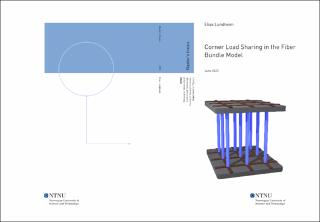| dc.contributor.advisor | Hansen, Alex | |
| dc.contributor.advisor | Sinha, Santanu | |
| dc.contributor.author | Lundheim, Elias | |
| dc.date.accessioned | 2023-09-30T17:22:10Z | |
| dc.date.available | 2023-09-30T17:22:10Z | |
| dc.date.issued | 2023 | |
| dc.identifier | no.ntnu:inspera:146341341:35443721 | |
| dc.identifier.uri | https://hdl.handle.net/11250/3093334 | |
| dc.description.abstract | Å forstå bruddmekanikk kan føre til sterkere matrial og tryggere bygninger. Bruddmekanikk er årsaken til at vinduer på fly er avrundet, og hvorfor taco-krydder-poser har små hakk på kanten. Fiber Bunt Modellen er en enkel model som fanger en fundamental del av bruddmekanikk. Den vil ikke kunne hjelpe deg med å finne den optimale formen på et flyvindu, men den kan hjelpe med med å forstå hvorfor en avrundet form er bedre.
Denne avhandlingen dekker en introduksjon til Fiber Bunt Modellen, Lokal Last Deling og en utforsking av en ny model: Hjørne Last Deling (HLD). Hjørne Last Deling, som navnet antyder, fokuserer på at hjørner burde tildeles mer last enn kanter, men er ellers identisk til Lokal Last Deling (LLD). Våre hoved resultat er at 1: Dimensjonaliteten til HLD bunter varierer kontinuerlig med uorden. 2: Lokalisering i HLD følger like etter, eller med en justert definisjon for lokalisering, like før total kolaps på en måte som LLD ikke gjør. Og 3: At den kritiske styrken til HLD bunter følger $\avsigmac \propto 1/\ln(\ln(N))$. Vi stiller flere åpne spørsmål for videre forskning: Hvorfor varierer dimensjonaliteten kontinuerlig? Hvorfor skalerer ikke $\avsigmac$ med $N$ i LLD, når den gjør det i HLD? Og hvorfor ser det ut som at den sprøe fasten stopper akuratt på $t_0=\langle \sigmathi \rangle/2$? | |
| dc.description.abstract | Understanding fracture mechanics can lead to stronger materials and safer buildings. Fracture mechanics is the reason why the windows on airplanes are rounded, and why the bags of taco spice have the tiny tear notches at the edges. The Fiber Bundle Model is a simple model that captures a fundamental effect of fracture mechanics. It will not be able to help you find the optimal shape of an airplane window, but it can help you understand why a rounded shape is better.
This thesis covers an introduction to the Fiber Bundle Model, Local Load Sharing and an exploration of a new model: Corner Load Sharing (CLS). Corner Load Sharing, as the name implies, emphasises that corners should experience more load than edges, but is otherwise identical to Local Load Sharing (LLS). Our main results are that 1: The dimensionality of CLS bundles varies continuously with disorder. 2: Localization in CLS very closely follows, or with a tuned definition of localization, precedes critical failure in a way LLS does not. And 3: That the critical strength of CLS bundles follow $\avsigmac \propto 1/\ln(\ln(N))$. We leave several questions open for further research: Why does the dimensionality vary continuously? Why does $\avsigmac$ not scale with $N$ in LLS when it does in CLS? And why does the brittle region seem to stop exacly at $t_0=\langle \sigmathi \rangle/2$? | |
| dc.language | eng | |
| dc.publisher | NTNU | |
| dc.title | Corner Load Sharing in the Fiber Bundle Model | |
| dc.type | Master thesis | |
